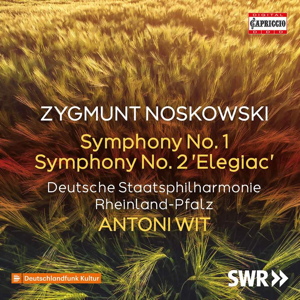
Zygmunt Noskowski (1846-1909)
Symphony No. 2 Elegiac (1875-79)
Symphony No. 1 in A major (1874-75)
Staatsphilharmonie Rheinland-Pfalz/Antoni Wit
rec. 2022, Ludwigshafen, Germany
Capriccio C5509 [80]
Despite what I thought at first, these are not first recordings; nor do they lay claim to be. I should have known better anyway because I – and others more successfully – attempted a review of three Sterling discs holding Polish composer Noskowski’s first three symphonies. Those Sterlings held one symphony apiece and achieved full measure in each case with a plethora of Noskowski’s smaller orchestral works. Not included in the Sterling discs was his rather good Slav tone poem The Steppe. By contrast, this disc from Capriccio has a tight focus on the two symphonies –presented in reverse numerical/chronological order.
These are works of an extravagant and leisured romantic proclivity. They are grandiloquent but rustic; illustrative and garrulous rather than tightly symphonic. Think middle period Dvořák – perhaps his Fifth and Sixth symphonies, the Slavonic Dances – rather than Brahms. Other kindred spirits would be Fibich and Paderewski in their symphonies and Janáček in his Lachian Dances. This is not to say that they are total strangers to drama but clearly Noskowski has an amblingly affable quality to his invention and gives vent to it.
The Elegia (Andante) movement (III) of the Second Symphony tempers the general air of playful relaxation with some cresting angry climaxes as if in protest at some unnamed tragedy. This lends the work a measure of vertebrate substance. The finale is a poem in sun-drenched fulfilment and occasionally imposing climactic writing. This symphony remains discursive with some vitality in its veins and arteries.
The First Symphony – also in four movements – is ten minutes longer than its successor. Again it is immersed in countryside pastel hues – as a parallel think not of Beethoven’s Seventh but of his Pastoral. As a further “triangulation” point I offer Ludolf Nielsen’s orchestral suites. The touching Adagio Cantabile – clearly hailing from a “peaceable kingdom” without quite achieving “Delectable Mountains” status – is very effective and almost Elgarian. Its Vivace is often fugal and somewhat Mendelssohnian; none the worse for that. The final Allegro con fuoco is modestly warm – a cheery autumn bonfire – rather than a flaming conflagration. Once again there is a modicum of fugal treatment without being mortally academic.
The sound on this disc nicely sustains the illusion of a grand hall without blunting the detail at a micro level. At the macro level there’s impact aplenty. As we are not comparing “like with like” I did not go back to the Sterling CDs but these performances as driven by Wit – a conductor familiar from many Naxos issues – are sympathetic. They do not lack enthusiasm and give every appearance of being technically adroit.
The really rather good notes in German and English by Jens T Laurson, who wrote for MusicWeb International, are spot-on: sympathetic and usefully informative. They avoid technical analysis of sort that makes most readers’ eyes and minds glaze over.
Capriccio have made a very good fist of two symphonies which are agreeable, little known and little heard, though not compelling.
Robert Barnett
Help us financially by purchasing from





















